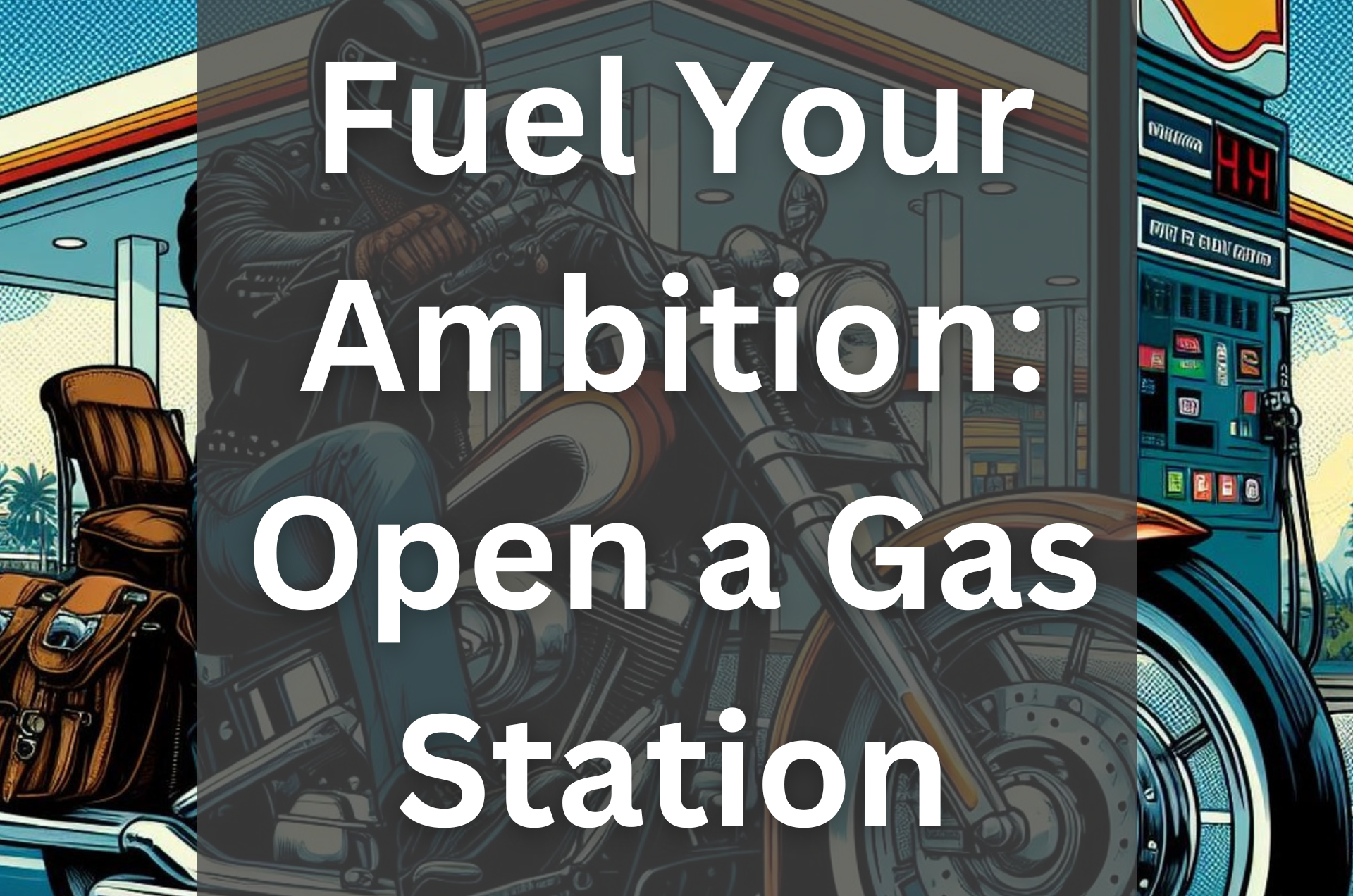**Disclosure:** We believe in honesty and transparency to the fullest extent. Some of the links on this blog are affiliate links, meaning, at no additional cost to you, we will earn a commission if you click through and make a purchase. This is one of the simplest ways you can support us.
Embarking on the journey of opening a gas station presents a fascinating opportunity for aspiring entrepreneurs looking to tap into a consistent demand. As an integral part of the American economic and social landscape, gas stations offer more than just fuel; they provide convenience and essential services to travelers and locals alike. To navigate this competitive but rewarding market, an entrepreneur must be equipped with a strategic approach, focusing on location, market research, and diversification of services. Here’s an enhanced guide, including investment estimates, to steer your path toward establishing a thriving gas station.
1. Location is Key
Choosing the right location cannot be overstated. A spot with high traffic, such as near highways or bustling neighborhood intersections, is ideal. Ease of access and minimal competition can significantly impact your station’s success. The initial cost for acquiring such prime locations may be higher, but the return on investment typically justifies the expense.
In considering your path to owning a gas station, purchasing an existing establishment presents a compelling opportunity. Our research indicates that the market offers gas stations starting at $150,000, a range that varies based on location, size, and revenue streams of the business. Opting to buy an existing gas station comes with several advantages, including a foundation with an established history to build upon. This path allows you to start with a clear salary expectation based on the station’s current financial performance, providing a tangible baseline for your business plans. Additionally, stepping into an existing operation means you have the unique opportunity to continue and potentially enhance its legacy within the community. This option not only simplifies some aspects of the startup process but also offers immediate operational insights and customer base, allowing you to focus on growth and improvements from day one.
Check out websites like https://www.bizbuysell.com/ to see what gas stations are currently on the market.
2. Conduct Comprehensive Market Research
Understanding your local market and competition is crucial. This insight will inform your service offerings and pricing strategy, enabling you to fill gaps in the market and meet unaddressed customer needs. Initial research might involve some costs related to surveys or data acquisition tools but can save significant amounts down the line by guiding strategic decisions.

3. Diversify Revenue Streams
Incorporating additional services like convenience stores, car washes, or quick-service restaurants can dramatically increase revenue. Initial setup costs for these services vary, with a convenience store setup ranging from $40,000 to $100,000, while a basic car wash setup could start around $100,000. These investments can lead to higher profit margins and a steady income beyond fuel sales.
Incorporating Electric Vehicle (EV) charging stations into your gas station can significantly broaden your customer base and future-proof your business as the world shifts towards sustainable transportation. The addition of EV charging stations caters to a growing demographic of EV owners, offering a valuable service that sets your station apart from competitors.
Benefits of Adding EV Charging Stations:
- Attracting New Customers: EV charging stations draw in environmentally conscious consumers and EV owners who may not have visited your station otherwise. This can increase foot traffic, benefiting other aspects of your business, such as convenience store sales.
- Government Incentives: Many regions offer tax credits, rebates, and grants for the installation of EV charging infrastructure, potentially reducing the initial investment costs.
- Increased Dwell Time: Charging an EV takes longer than filling up a gas tank, meaning customers are likely to spend more time at your location. This presents a greater opportunity for sales in convenience stores or other on-site services.
- Environmental Impact: By supporting cleaner transportation options, you contribute to reducing carbon emissions, aligning with global sustainability goals and enhancing your brand’s image as environmentally responsible.
- Future Profitability: As the adoption of electric vehicles continues to rise, early investment in EV charging infrastructure can position your gas station as a leader in the evolving automotive fuel market, ensuring long-term profitability.
Considerations for Implementation:
- Cost: The cost of installing EV charging stations can vary widely based on the type of charger (Level 2 or DC Fast Charging) and site-specific requirements. Initial investments may start from around $6,000 for a basic Level 2 charger to over $50,000 for a DC Fast Charger, not including potential infrastructure upgrades.
- Charging Fees: Decide on a pricing strategy for charging services. Options include per kWh pricing, a flat fee per session, or subscription models. Competitive pricing can attract more EV drivers to your station.
- Location and Space: Evaluate your property to determine suitable locations for EV chargers that don’t interfere with traditional fueling spaces. Consider factors like accessibility, visibility, and proximity to the convenience store or other amenities.
- Partnerships: Explore partnerships with EV charging network providers or automotive manufacturers. These collaborations can offer access to advanced technology, maintenance support, and increased visibility among EV owners.
By integrating EV charging stations, your gas station not only serves the current market but also embraces the shift towards electric mobility, ensuring your business remains relevant and competitive in the changing automotive landscape.
4. Stay Updated on Fuel Prices
Fuel price volatility requires constant attention. Developing a flexible pricing strategy can help maintain competitiveness and profitability. Investing in software for price tracking and management might require an initial outlay but ensures agility in a fluctuating market.
5. Invest in Technology
Modernizing operations with advanced POS systems and loyalty programs requires an initial technology investment of $10,000 to $50,000, depending on the scale and sophistication of the systems. This not only enhances efficiency but also improves customer experience, fostering loyalty and repeat business.
6. Safety First
Safety measures are non-negotiable, with initial investments in quality equipment, surveillance, and lighting potentially costing upwards of $20,000. Regular maintenance and updates to safety protocols protect both customers and staff, and safeguard your business against liabilities.
7. Hire and Train Efficiently
Assembling a skilled and friendly team is essential. Initial costs include recruitment, salaries, and ongoing training programs. Allocating $5,000 to $10,000 for initial training programs can ensure high service standards and adherence to safety protocols.
8. Build Relationships with Suppliers
Securing favorable terms with fuel suppliers might require negotiation skills and possibly a consultant’s advice, which could cost $2,000 to $5,000. However, this can result in long-term savings and reliability in fuel supply.
9. Engage with the Community
Community engagement initiatives might have variable costs, from a few hundred to several thousand dollars, depending on the scope. These activities not only build brand loyalty but also integrate your business into the local fabric, generating positive word-of-mouth.
10. Stay Environmentally Conscious
Investing in eco-friendly technologies and practices might start with a modest investment of $5,000 to $20,000 but can significantly enhance your brand’s appeal and contribute to operational savings over time.
Estimated Total Investment:
Starting a gas station can require a significant upfront investment, generally ranging from $250,000 to over $1 million, encompassing land acquisition (if not leased), equipment, initial stock, and additional service setups. This estimate varies widely based on location, size, and the range of services offered.
Conclusion
Launching a successful gas station is a multifaceted venture, demanding not just financial investment but strategic planning, market insight, and a commitment to quality service. By focusing on the right location, diversifying revenue streams, and staying attuned to customer needs and safety standards, you can establish a profitable and sustainable business. Remember, success in the gas station industry is fueled by more than just gasoline; it’s driven by strategic foresight, community engagement, and adaptability to market trends.










